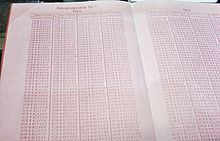Tony Fasson
Francis Anthony Blair Fasson (born July 17, 1913 in Lanton (Scottish Borders) , † October 30, 1942 in the Mediterranean ), called Tony Fasson , was a British naval officer in World War II . Through heroic Capture top secret Enigma - key documents , in which he met his death, he influenced the course of the war.
Life

As first officer of the British destroyer HMS Petard , he succeeded on October 30, 1942, in the middle of the World War, in the eastern Mediterranean, about 140 km north of Port Said ( Lage ), together with his comrades Colin Grazier (1920–1942) and Tommy Brown ( 1926–1945), secret code books , such as short signal booklet and weather short key , to be captured from the German submarine U 559 . The secret material was taken to Bletchley Park , the British central cryptanalysis center located about 70 km north of London , and helped the Codebreakers there to break into the Enigma-M4 rotor key machine used by the Kriegsmarine .
Fasson and Grazier drowned in this action. Posthumously Tony Fasson received the Georgs-Kreuz ( English George Cross ) "for outstanding bravery and steadfast devotion to duty in the face of danger" ( German "for outstanding bravery and unshakable fulfillment of duty in the face of danger" ). He held the rank of lieutenant .
Cinematic reception
In the British feature film Enigma - The Secret , which is based on the novel Enigma , and which deals with the deciphering work of the British code breakers in Bletchley Park, the names Fasson and Grazier are mentioned in connection with the captured short signal booklet and weather short key .
War-historical significance
Since February 1, 1942, when in the German submarine key network "Triton" , called by the British Shark ( German "Hai" ), the previously used Enigma-M3 (with three rollers) through the M4 (with four rollers) had been replaced, the British secret service could no longer decipher the encrypted German radio messages . This painful interruption ( black-out ) lasted ten months and was a phase in which the German submarine weapon was again able to record great successes. The submariners called them their "second happy time" . With the help of the secret material captured by U 559, the British cryptanalysts succeeded in “reading” the German submarine radio messages again from December 12, 1942 . In this way, the convoys of war importance for the United Kingdom could be diverted around the German submarine packs and the British population and the war economy could be supplied with food and production goods.
Renowned British cryptologist and historian Ralph Erskine summed it up as follows in a report published in 1988:
“All the work that was done at Bletchley Park to crack Triton would have been completely inconclusive had it not been for the men at the front. Without the brave deed of Lieutenant Antony Fasson, Able Seaman Colin Grazier and 16-year-old Tommy Brown, who recovered the weather key and the short signal booklet on U-559, we would not have had any special intelligence services during the first half of 1943, which was decisive for the further course of the battle in the Atlantic Get information from Triton. There are few acts of personal bravery that have ever had such far-reaching consequences. Without the special knowledge from Triton, the submarines would have been defeated in the long run, but the loss of human life in this global conflict would have been far worse than it already was. "
literature
- Stephen Harper: The Battle for Enigma - The Hunt for U-559 . Mittler, Hamburg 2001, ISBN 3-8132-0737-4 .
Web links
- Portrait photo at the Scottish National Museum accessed December 8, 2017
- The Capture of the Wetterkurzschlussel and Kurzsignalheft from U-559 (English) accessed on December 21, 2017
- The heroes of U-559 - an Enigma mystery at the Scottish National Museum. Retrieved December 8, 2017
- The Documents recovered from U559 - at a price from Tony Sales Codes and Ciphers. Retrieved December 8, 2017
- Sci-Tech Tuesday - 70th Anniversary of Enigma Capture from U-559 at the National World War II Museum. Accessed December 8, 2017
Individual evidence
- ↑ Stephen Harper: The Battle for Enigma - The Hunt for U-559 . Mittler, Hamburg 2001, p. 50 ff. ISBN 3-8132-0737-4 .
- ↑ Stephen Harper: The Battle for Enigma - The Hunt for U-559 . Mittler, Hamburg 2001, p. 66 ff. ISBN 3-8132-0737-4 .
- ^ The London Gazette, September 14, 1943, PDF; 340 kB (English) accessed on December 12, 2017
- ^ Fasson, Francis Anthony Blair from TracesOfWar, accessed December 8, 2017
- ↑ Robert Harris: Enigma . Novel. Weltbild, Augsburg 2005. ISBN 3-89897-119-8 .
- ^ Hugh Sebag-Montefiore: Enigma - The battle for the code . Cassell Military Paperbacks, London 2004, p. 225. ISBN 0-304-36662-5 .
- ↑ Michael Smith: Enigma decrypted - The "Codebreakers" from Bletchley Park . Heyne, 2000, p. 181. ISBN 3-453-17285-X .
- ^ Rudolf Kippenhahn: Encrypted messages, secret writing, Enigma and chip card . Rowohlt, Reinbek bei Hamburg 1999, p. 247. ISBN 3-499-60807-3 .
- ↑ Stephen Harper: The Battle for Enigma - The Hunt for U-559 . Mittler, Hamburg 2001, p. 135, ISBN 3-8132-0737-4
| personal data | |
|---|---|
| SURNAME | Fasson, Tony |
| ALTERNATIVE NAMES | Fasson, Francis Anthony Blair |
| BRIEF DESCRIPTION | British lieutenant captain |
| DATE OF BIRTH | July 17, 1913 |
| PLACE OF BIRTH | Lanton (Scottish Borders) |
| DATE OF DEATH | October 30, 1942 |
| Place of death | Mediterranean Sea |